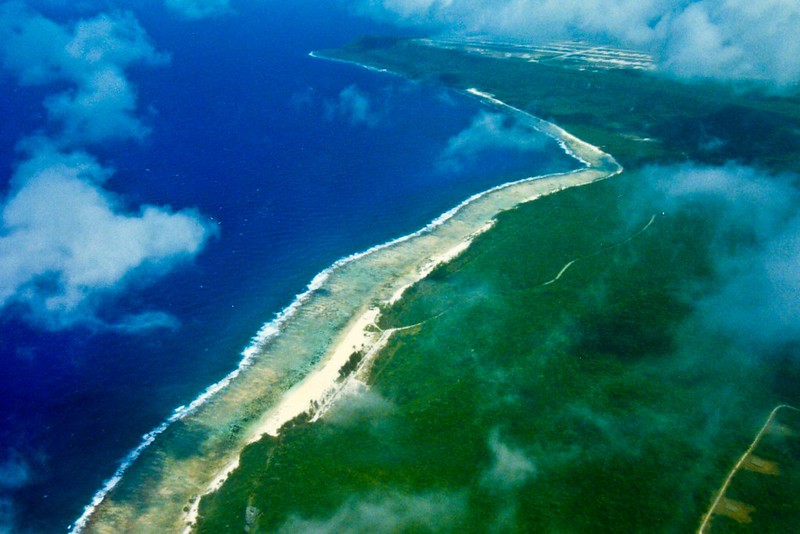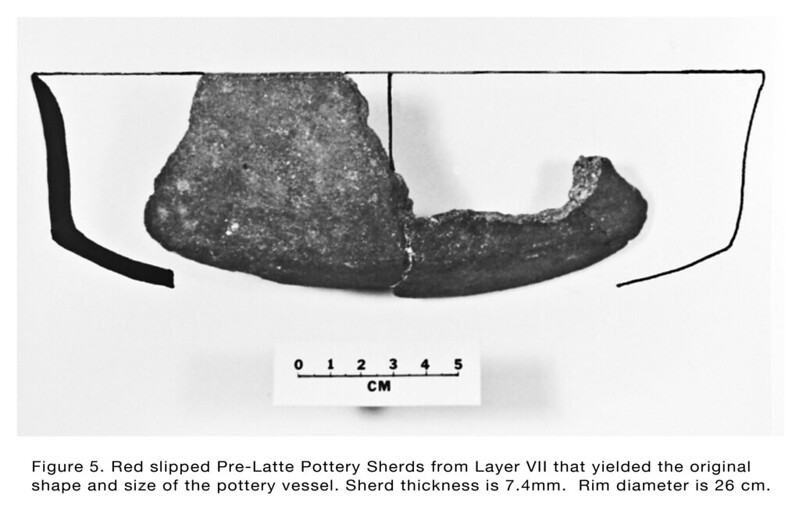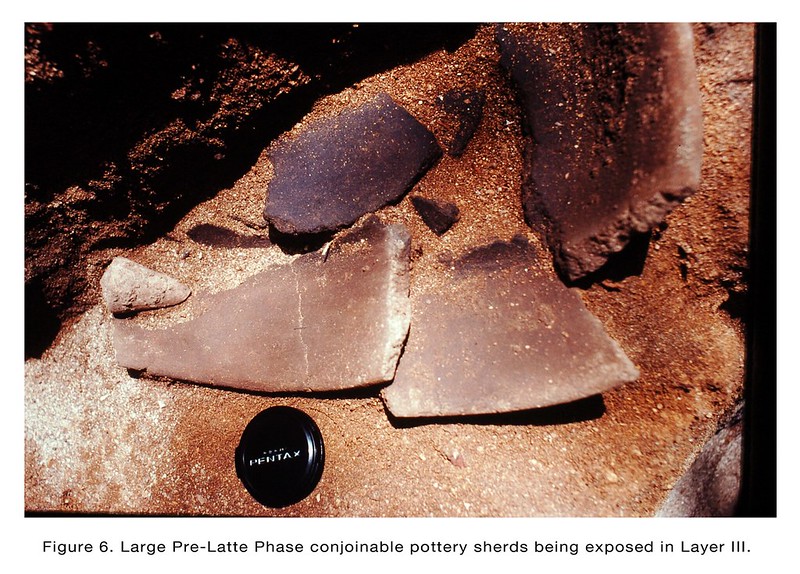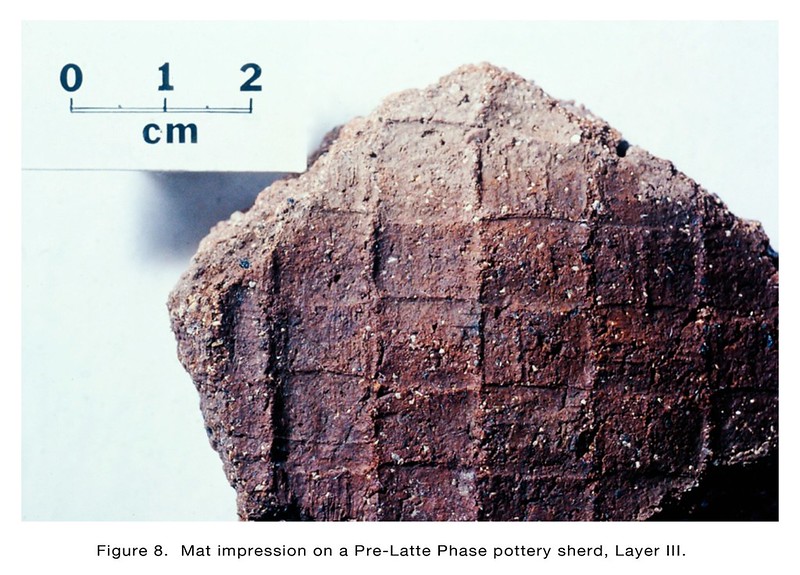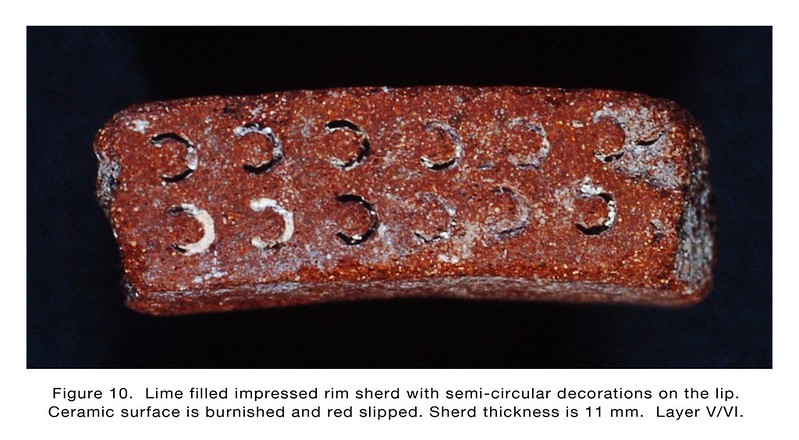Tarague (Talågi)
Northern shores of Guam
Tarague is a geographic place name given to the northern littoral of the island of Guam, between Mergagan Point to the west and Tagua Point to the east. In historic maps and accounts of Guam dating back to the Spanish Era of the island (16th – 19th centuries), the orthography of the word Tarague varied. It was at times spelled, for example, as “Tarragui” and “Taragay.” In the modern day USGS maps, the spelling of “Tarague” is used consistently. Another spelling, “Talagi,” was introduced by the Guam Historic Preservation Office in April 2006. At the present time, Tarague is located within the Andersen Air Force Base, and access to the Tarague area is restricted.
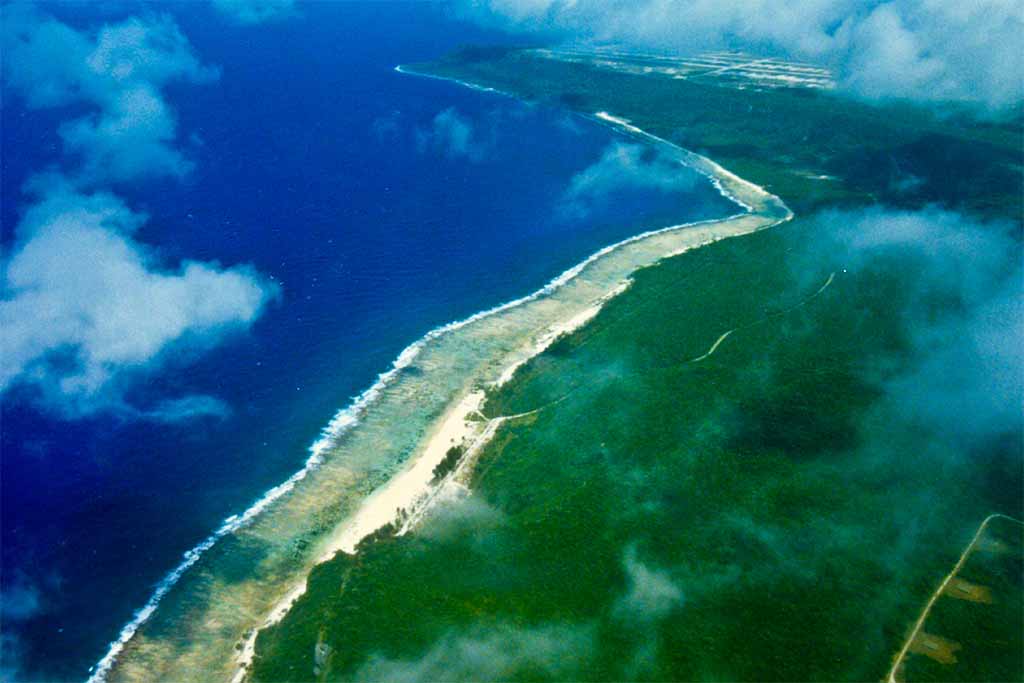
The landscape at Tarague is characterized by the following successive resource-rich broad spectrum micro-environments, encompassing the open sea (in CHamoru: tasi), the coral reef (ribentason), the lagoon (hagoe), the channel (kannet), the coastal plain, the limestone escarpment, and the raised limestone plateau. Intrinsically, the area at Tarague must have provided an excellent locale for yielding high bioproductivity for the settlers of Tarague. For example, the coral reef at Tarague which represents a major environmental feature, provides a variety of habitats for peripheral reef dwellers, including fish, shellfish, algae, corals, crabs, sea urchins, and other marine organisms.
The vegetation at Tarague, as identified by Dr. Ray Fosberg of the Smithsonian Institution in 1980, includes twenty-three species of trees and shrubs, eight species of vines, three species of ferns, six species of grasses and sedges, and fifteen species of other herbs. A highly valued ifil (Intsia bijuga) is present within the plant community at Tarague. Many of the plants are useful species for subsistence economy, medicinal practices, and material culture production.
In the faunal community, there are colonies of fruitbat in the forest along the limestone escarpment to the east of Tarague. Wild pigs, deer, and monitor lizards the main terrestrial fauna.
Freshwater is available in the form of a Ghyben-Herzberg ground water lens system that can be reached through digging wells. Some of the ancient wells still exist in the sandy coastal plain at Tarague. At least one of the ancient wells at Tarague is stone-lined on the sloping interior walls. There is also a limestone cave with freshwater at Tarague. A number of surge channels created by freshwater runoff are present along the coastal margin. The Tarague Channel cut in the reef is approximately 31 meters in width, and must have afforded easy access for both incoming and outgoing canoes during the prehistoric and early historic periods on Guam.
The coastal plain at Tarague rises gradually to meet the foot of the 152-meter (500-ft.) high Pliocene-Pleistocene limestone cliff and forms a crescent-shaped land area. The distance between the shoreline and the base of the limestone escarpment is as much as 610 m (2,000 feet). The base of the limestone escarpment is nearly 30.5 m (100 feet) above the present sea level. The prehistoric settlement area at Tarague is extensive and extends more than 3 km (2 miles) in the coastal plain on either side of the Tarague Channel, having an estimated land area of approximately 1.1 km2.
[Geological Dates: The Pliocene Epoch dates from about 5.3 to 2.5 million years ago, and the Pleistocene Epoch from about 2.5 million to 12,000 years ago. This corresponds to the Paleolithic Age in archeology, which is the age in prehistory when humans began developing stone tools. The Pleistocene is followed by the Holocene Epoch, which continues to the present.]
The distance between the shoreline and the base of the limestone escarpment is as much as 610 meters (100 ft.) above the present sea level. The prehistoric settlement area at Tarague is extensive and extends more than 3 kilometers (2 miles) in the coastal plain on either side of the Tarague Channel, having an estimated land area of approximately 1.1 square kilometers (about 0.42 square miles).
Archeological investigations at Tarague
Prior to the long-term research conducted at Tarague by the University of Guam in the 1980s, archeological survey and limited excavations were conducted along the northern littoral of Guam by Hans Hornbostel in the 1920s, Douglas Osborn in 1946, Erik Reed in 1952, Fred Reinman in 1965-66, and Col. Erwin Ray in the mid 1960s.
The presence of pictographs (cave wall drawings) inside a limestone cave at Tarague was initially noted by Hans Hornbostel in the 1920s. Ray’s archeological work was important, as the results of his subsurface testing revealed the presence of both Pre-Latte and Latte cultural deposits.
The research conducted at Tarague in the 1980s by the University of Guam (UOG) was interdisciplinary, and encompassed scholars in various areas of specialization that included archeology, anthropology, geology, geomorphology, botany, and marine biology. More than 100 University of Guam students had the opportunity to receive training in archeological field and laboratory methodology during the course of the interdisciplinary research at Tarague. A graduate thesis by Darlene Moore that resulted in a Master’s Degree was produced using the data obtained at Tarague in 1983.
The sources of funding for the University of Guam’s research endeavors at Tarague included the National Geographic Society in Washington, DC, the Gannet Foundation in New York, and the Research Council at the University of Guam. The study at Tarague by the UOG team was carried out under a Federal Antiquities Act Permit issued by the US Department of the Interior. Following the research undertaken by the University of Guam team, further archeological studies at Tarague were conducted by Darlene Moore and Judy Amesbury in the mid-1980s, Jolie Liston and her associates (Liston et al. 1996), Richard Olmo in the 1990s, and personnel of the Guam Historic Preservation Office (April 2006) who made a detailed documentation of pictographs at Tarague. The pictographs include a number of stylized human figures drawn using white pigment. Bedrock mortars were recorded near the pictographs.
Evolution of the settlement
The high density of prehistoric cultural remains appears to be generally correlated with the nature of the ground geology at Tarague. Archeological sites as indicated by occasional latte stones, pottery, marine shells, and other forms of artifacts and ecofacts commonly occur along the contour elevation of 7 meters (23 ft.) above the present day sea level.
The research undertaken by the UOG team at Tarague revealed that the archeological sites, including their subsurface cultural deposits, rest on a former reef-lagoon system that was active during mid-Holocene times. The bedrock found at a depth of more than 6 meters (about 20 ft.) from the surface at the main archeological excavation site at Tarague was identified as Malesso’/Merizo Limestone by Richard Randall of the University of Guam Marine Laboratory.
A radiocarbon date obtained for the basal deposit at a depth of 6.3 meters (21 ft.) below Alpha Datum (a datum line or point of reference from which all other measurements are taken) at one of the main Tarague archeological excavation sites is in agreement with the age range of the Malesso’ Limestone, which dates back to about 3,000 to 5,000 years ago. The coastal geomorphology (the scientific study of landforms and the processes that shape them), especially the shoreline, has changed due to regression or lowering of the sea level during the Holocene. The research at Tarague indicates that the date associated with the basal deposit coincides, and possibly overlaps, with dates of the emergent Malesso’ Limestone.
Above the base of the stratigraphic sequence, there are 10 distinguishable layers of sediment deposition.
The ten layers are designated by I (top) through X (bottom). While Layer I contained Latte Phase cultural remains, Layers II, III, V, VII, and VIII yielded Pre-Latte cultural assemblages that attest to the considerable time span of early human occupation present at Tarague. Layers IV, and VI consisted of storm deposited white sand with a low frequency of artifacts. The lowest deposits in Layers IX and X were devoid of cultural remains. Layer IX, close to the bottom of the stratigraphic sequence at Tarague, was a zone characterized by water table cementation. This cementation produced a “hard layer” of consolidated bioclastic sediments slightly above the present mean sea level. Layer X represented a paleo-environment associated with a shoreface in the littoral zone. The stratigraphy at Tarague has shown a facies change with sediment deposition shifting from a foreshore environment in the lowest layers (Layers IX and X) to a backshore environment in the layers above (Layers I through VIII).
The entire stratigraphic sequence can be estimated to have been deposited over about the last 4000 years. The lowest artifact-bearing deposit of Layer VIII produced a radiocarbon age of 3435+/-70 B.P. (1485 +/- 70 B.C.). The transition from the Pre-Latte Phase to the Latte Phase in Layer I yielded an age of 1150 +/- 80 B.P. (800 +/- 80 A.D.). Figure 2 shows a series of original C14 dates as reported by radiocarbon laboratories during the course of research at Tarague conducted by the University of Guam team.
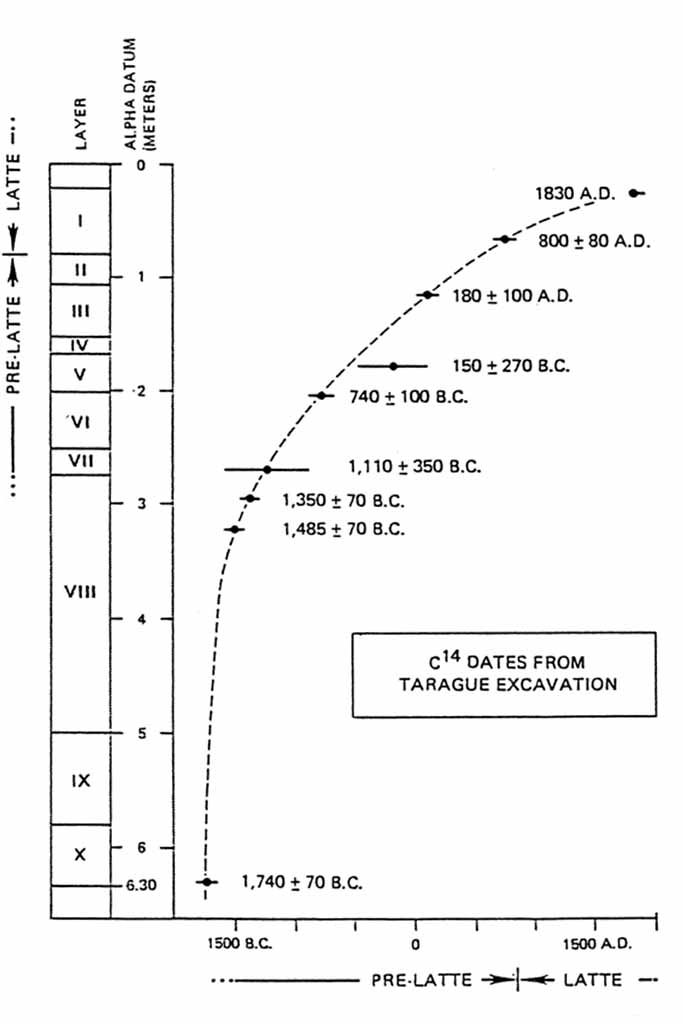
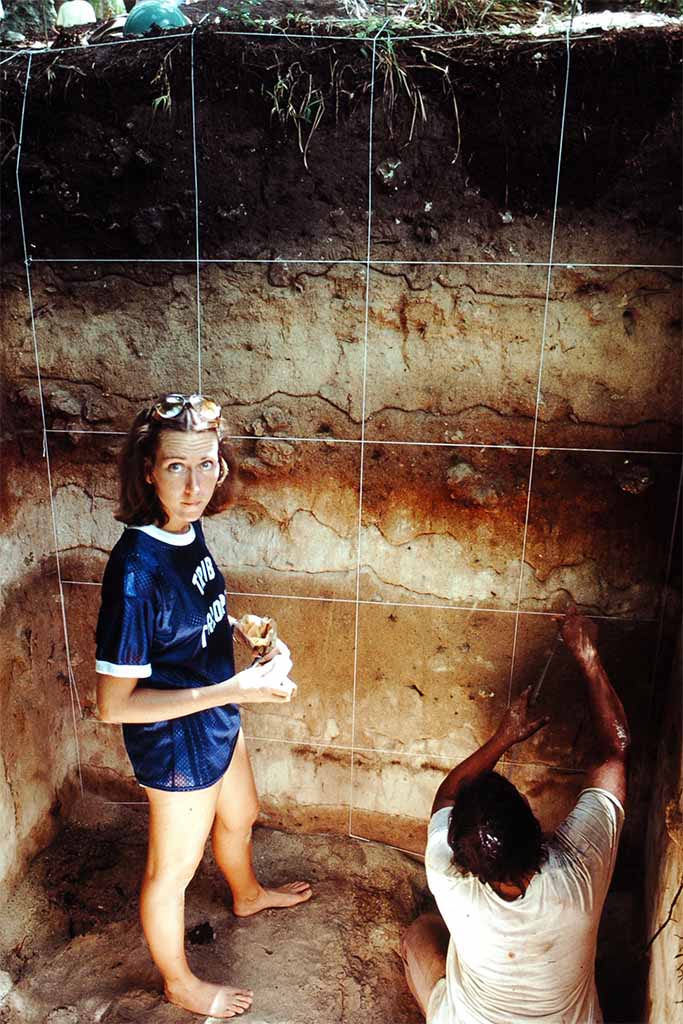
The cultural assemblages excavated from the deeply stratified deposits at Tarague afforded an excellent opportunity to examine the longitudinal changes in the material culture and other associated remains (Figure 3). The changes observed through time include the ceramic morphology, as shown in Figure 4. During the long prehistoric sequence, the ceramic vessel shape underwent significant changes over a period of 3.5 millennia. In the early stages of human settlement, relatively small red slipped pottery vessels (known as Marianas Red Ware) with restricted openings appear first. Many of the early red slipped pottery vessels have carinated walls.
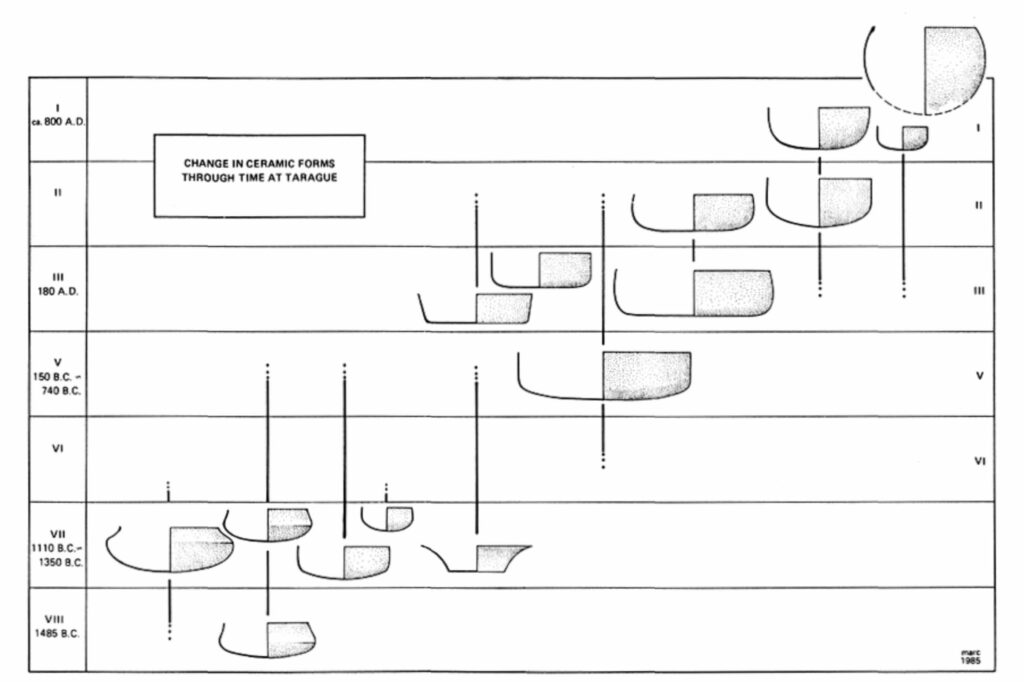
This type of pottery vessel continues to exist through Layer V. Examples of Pre-Latte pottery sherds excavated at Tarague are illustrated in Figures 5, 6, 7, 8 and 9. The sherds in Figures 8 and 9 show woven mat impressions. Pottery vessels with unrestricted openings appear first in Layer VII and continue to persist through time with variations in size up to Layer I. Flat-bottomed shallow vessels with flared walls are present in Layers VII and V. The flaring is reduced to everted walls with some shallow flat-bottomed vessels found in Layers III and II. Other flat-bottomed shallow vessels found in Layers III and II exhibit slightly incurving walls. Slightly round-bottomed vessels with an increased wall height appear in Layer III and continue through Layers II and I. In Layer I, deep globular pots with restricted openings dominate the vessel shape. The radiocarbon dates and the ceramic sequence obtained at Tarague are closely comparable to those recently published by Mike Carson in 2008 concerning his deeply stratified archeological site at Unai Bapot on Saipan.
Relatively rare lime-filled impressed ware was present at Tarague only in limited quantities. The lime filling was seen in geometric designs either stamped or incised in the paste. These designs appeared on the lip or exterior body portions of pottery vessels. Figure 10 illustrates a lime-filled impressed ware found in a Pre-Latte deposit at Tarague.
Archival research conducted at the Micronesian Area Research Center indicates that there was once a thriving village at Tarague during the Spanish Era. The location of the village appears to have been in the east-central portion of the coastal plain near the Tarague Channel, according to a map produced by French explore Louis de Freycinet in 1819. The Spanish missionaries built a church at Tarague which must date to sometime during the latter part of 1600s. No structural remains of the church built at Tarague have been identified to date, most likely owing to earth-moving activities that took place after the end of World War II.
Land use during the time of the early US Naval Period at Tarague included copra production. Atkins Kroll operated a copra plantation at Tarague from 1918 to 1930. By 1930, the price and demand for copra had dropped and it was no longer tenable for Atkins Kroll to continue its copra business in northern Guam.
During the brief period of Japanese occupation of Guam (1941 – 1944), Tarague was of both military and civilian significance. Satoh Kazumasa gives the following details:
… An interim Colonel named Ohashi was selected to command a regiment stationed at Tarague … Commander Yukioka of the Navy and Second Lieutenant Yamashita ordered the ships . . . to head for Guam [from Saipan], to land at Tarague Beach
A substantial number of Japanese people were residing at Tarague prior to the end of World War II. Satoh indicated:
Directly in front of Tarague Beach, there was a coconut forest which was called Takano field. The forest was named after Kosaku Takano, former owner of the coconut field. In this forest, two to three thousand Japanese resided. The Japanese, however, were not members of any military organization.
After the liberation of the island of Guam by US Armed Forces in 1944, the northern portion of Guam was transformed into a large military base initially named North Field. Later, in 1949, its name was changed to Andersen Air Force Base, in honor of Brigadier General James Roy Andersen (1904-1945).
Tarague’s significance
The Tarague site on Guam is culturally very important, as it has yielded deeply stratified archeological deposits dating back to the 2nd millennium BC. An extensive period of human occupation from the early Pre-Latte to later Latte Phase is well represented at Tarague.
Word list
Limestone – the primary rock type found in the northern and central parts of Guam. Composed of fossilized coral and algae, limestone is permeable, meaning water can penetrate it, much like going through a filter. When rainwater is absorbed by the land, it percolates through the limestone to the harder bedrock below until it reaches sea level. Because freshwater is lighter than salt water, it “floats” on top. The interaction of the two types of water creates a kind of boundary that resembles a “lens” – geologically, this is known as a Ghyben-Herzberg lens, or locally, as the Northern Guam Lens. The filtered rainwater collects in what is now known as the Northern Guam Aquifer, providing an abundant source of freshwater. The ancient Chamorros living in Tarague were able to access this fresh water from wells they would dig in the limestone.
Different Limestones – of the different kinds of limestone formed throughout Guam, Malesso’ Limestone is the most recent, having emerged during the Holocene, about 2,500 to 4,800 years ago. This type of limestone is generally 2-12 feet thick and formed on top of reef floats. An older type of limestone called Mariana Limestone, formed during the Pliocene and Pleistocene, and is found primarily at Ritidian Point in northern Guam. It is estimated to be between 550 and 600 feet thick.
Stratigraphy – a technique used by archeologists to understand changes over time by looking at layers of rock deposits and soil formations. In an archeological excavation site, older layers of soil are deeper or lower an dmore recent layers are higher or closer to the ground surface. The layers in a stratigraphic study can demonstrate environmental changes as well as reveal a time sequence for the various artifacts and ecofacts present in each layer.
Littoral Zone – although there are various definitions and associated terms, the littoral zone generally refers to an area closest to the shore of the sea, river or lake. The foreshore refers to the area on the shore that is still affected by the movement of tides, while the backshore is demarcated by the high tide water mark to where inland vegetation begins. The term facies refers to the characteristics of a particular unit of rock. The way in which soils are deposited will determine the facies of a particular area. At Tarague, the deeper layers demonstrate a change from foreshore to backshore as water levels regressed (lowered).
Radiocarbon Dating – a technique used to assign an age to archeological remains. It is based on the rate of breakdown or radioactive decay over time of a form (or isotope) of carbon, known as Carbon-14. It is particularly useful for dating organic remains (i.e. the remains of living things, which are made of carbon) by measuring the relative levels of Carbone-14 still present. The ages calculated by radiocarbon dating is often written with the abbreviation “PB”, or “Before Present”. This is traditionally meant as “before 1950” which was the date selected by archeologists.
Carinated Pottery – pottery characterized by having a round base, which is attached to inward sloping walls.
For further reading
April, Vic. “Talagi Pictograph Cave, Guam.” Micronesian Journal of the Humanities and Social Sciences 5, no. 1/2 (November 2006): 53-69.
Bellin, Jacques Nicolas. Carte De L Archipel de St Lazare ou les Isles Marianes…1752. Map. In L`Histoire Generale des Voyages. By Antoine-François Prevosts. Paris: Diot, 1752.
Carson, Mike T. “Refining Earliest Settlement in Remote Oceania: Renewed Archaeological Investigation at Unai Bapot, Saipan.” Journal of Island & Coastal Archaeology 3, no. 1 (2008): 115-139.
Freycinet, Louis Claude Desaulses de. An Account of the Corvette L’Uraine’s Sojourn at the Mariana Islands, 1819. Translated by Glynn Barratt. Saipan: Commonwealth of the Northern Mariana Islands Division of Historic Preservation, 2003.
Kurashina, Hiro, and Russell N. Clayshulte. Site Formation Processes and Cultural Sequence at Tarague, Guam. Mangilao: Micronesian Area Research Center, University of Guam, 1983.
Kurashina, Hiro, Darlene Moore, Osamu Kataoka, Russell Clayshutle, and Erwin Ray. “Prehistoric and Protohistoric Cultural Occurrences at Tarague, Guam.” Asian Perspectives 24, no. 1 (1984): 57-68.
Liston, Jolie, Claudine M. Camacho, Richard H. Randall, and M. J. Tomonari-Tuggle.The Legacy of Tarague Embayment and its Inhabitants, Andersen AFB, Guam. Vol. 1, Archaeology. Honolulu: International Archaeology, Inc., 1996.
Lopez, Alonso. Carte de l’Archipel de St. Lazare ou les Isles Marianes. 1764 Map.
Moore, Darlene R. “Measuring Change in Marianas Pottery: The Sequence of Pottery Production at Tarague, Guam.” MA thesis, University of Guam, 1983.
National Geographic Society. Understanding the Origins of Human Settlement in Micronesia: Interdisciplinary Investigations at Tarague, Guam, Mariana Islands. By Hiro Kurashina, Erwin Ray, Russell Clayshulte, Steve Amesbury, Richard Randall, Barry Smith, and Rebecca A. Stephenson. Mangilao: MARC, 1987.
Osborn, Douglas. “Chamorro Archaeology.” Unpublished manuscript, 1947, typescript. University of Washington.
Ray, Erwin R. “The Material Culture of Prehistoric Tarague Beach, Guam.” MA thesis, Arizona State University, 1981.
Reinman, Fred. An Archaeological Survey and Preliminary Test Excavations on the Island of Guam, Mariana Islands, 1965-1966. Mangilao: Micronesian Area Research Center, University of Guam, 1977.
–––– Notes on an Archaeological Survey of Guam, Mariana Islands, 1965-1966. Mangilao: Micronesian Area Research Center, University of Guam, 1977.
–––– Notes on an Archaeological Survey of Guam, Mariana Islands, 1965-1966. National Science Foundation (Grant #G5-662). Mangilao: Micronesian Area Research Center, University of Guam, 1966.
Thompson, Laura M. Archaeology of the Mariana Islands. Bernice P. Bishop Museum Bulletin, No. 100. Honolulu: Bishop Museum Press, 1932.
US Department of the Interior National Park Service. General Report on Archeology and History of Guam. By Erik K. Reed. Sante Fe: NPS, 1952.
